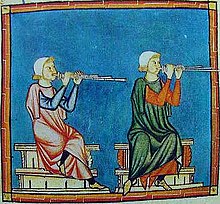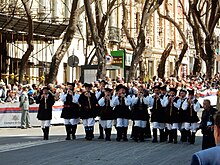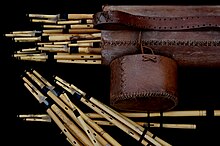Launedda


The launeddas are a traditional Sardinian wind instrument with single-reed , which has been there since about 2900 years in use. They consist of two shorter melody tubes ( mancosedda and mancosa manna ) and a longer third drone pipe without finger holes ( tumbu ).
The two melody tubes have four rectangular finger holes, underneath is a fifth, elongated vocal and sound hole. The pipes and reeds are made from pile pipe and the Sardinian pipe variety arundo pliniana turra . The tongues of the reed are weighted down with lumps of wax to create a mood.
The launeddas are used in different sizes and moods and played in different combinations. A leather quiver ( straccasciu ) is used to store the various melody tubes .
Style of play
The two melody pipes are usually played polyphonically in two parts . The left hand simultaneously holds the tumbu and the mancosedda , which are also connected to each other ( croba ). The right hand plays the melody-leading mancosa manna . Traditionally, the launeddas are played with circular breathing . The Launeddas are played on social occasions in rural and church life, especially to accompany parades and Sardinian dances.
History and dissemination
The launeddas are related to the single-reed instruments in ancient Egypt . A phallic bronze statuette found in Sardinia shows a preform with three cylindrical tubes of equal length, similar to the benas that have been preserved in Sardinia to the present day . The figure, about eight centimeters high, shows a player grasping the playing tubes with outstretched arms at the lower end. It is dated to around 1000 BC. Dated. Thus the Sardinian reed instruments are older than the Greco-Roman aulos .
In the Middle Ages, triple instruments were also widespread in other European regions. Images with three parallel sound tubes are shown (two of which are drone tubes without finger holes). They come from the Iberian Peninsula ( Cantigas de Santa Maria ) and from an English manuscript (Codex of the Canterbury School, 12th century).
Similar to Sardinia, instruments with single reeds and cylindrical bores have survived, especially in the Mediterranean and the Near East. These include the Turkish sipsi (simple sound tube), the Lebanese midschwiz (two melody pipes of the same length, without drone pipe) and the Egyptian arghul (a shorter melody pipe, a drone pipe).
The mood of the melody and drone pipes is clearly similar to the Laotian bamboo mouth organ khaen , as it is also played in Sardinia. Christian missionaries brought the khaen to Europe on their return in the 19th century . The Sardinian shepherd broadcast the game, the launeddas to the Southeast Asian reed wind instrument .
Performers
Famous Sardinian Launedda players are for example Fabio Melis, Luigi Lai, Antonio Lara and Dionigi Burranca. Many launedda players build their own instruments, for example Cesare Carta, a launedda master from the city of Nuoro in Barbagia (Sardinia).
See also
literature
- Andreas Fridolin Weis Bentzon: The Launeddas: a Sardinian Folk-music Instrument. ( Acta Ethnomusicologica Danica No. 1 ) Akademisk Forlag, Copenhagen 1969, Volume 1 and Volume 2
- Roberto Leydi: Launeddas. In: Grove Music Online, January 31, 2014
- Gian Nicola Spanu (Ed.): Sonos - Strumenti della musica popolare sarda. Ilisso Edizioni, Istituto Superiore Regionale Etnografico, Nuoro 1994, ISBN 88-85098-30-4 , online edition. Retrieved September 4, 2016 . (PDF; 9.8 MB), pp. 136–160
Web links
- Helmut Brand: The afterlife of ancient aulos music in European and Turkish-Arabic music. musikarchaeologie.de
- I launeddas a Sardegna canta. Youtube video
Individual evidence
- ↑ Heinz Becker: On the history of the development of ancient and medieval reed instruments. Hamburg 1966, p. 111
- ↑ For the instruments depicted in the Cantigas manuscripts , cf. the representation Medieval Instruments VIb, Winds ( Memento from February 2, 2009 in the Internet Archive )
- ↑ Becker, History of Development, p. 112
- ^ Gisa Jähnichen: Sardinian Air in Lao Pipes. (PDF; 930 kB) Studia Instrumentorum Musicae Popularis XVI. ITCM Study Group on Folk Music Instruments. Proceedings from the 16th International Meeting, 2006

